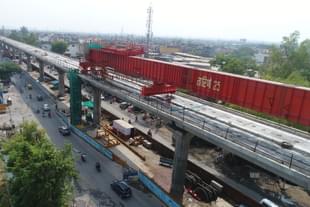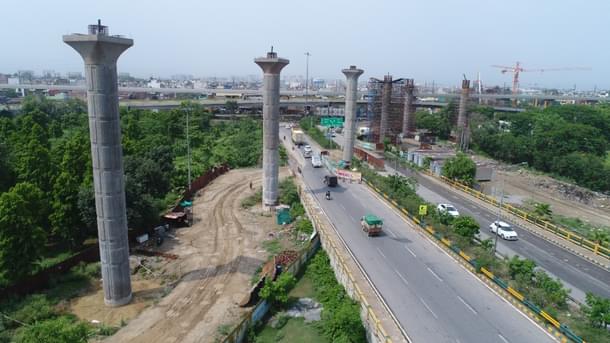News Brief
More Than One-Third Piers Of India's First Regional Rail Ready
Arun Kumar Das
Jul 13, 2021, 01:37 PM | Updated 01:37 PM IST
Save & read from anywhere!
Bookmark stories for easy access on any device or the Swarajya app.


Expediting the works with due Covid safety protocols, National Capital Region Transport Corporation (NCRTC) has completed more than one-third piers of the elevated stretch of India's first regional rail to connect Delhi to the urban nodes of Ghaziabad, Modi Nagar and Meerut.
In the 82 kilometres long Regional Rapid Transit System (RRTS) corridor, a total of 70 km area is elevated, out of which piers have been erected in a 24 km stretch so far.
On this corridor, a 12 km portion is to be constructed underground, of which about 4 km is in Delhi, and 8 km is in Uttar Pradesh.
According to the NCRTC, activities have picked up pace at Anand Vihar for the construction of the underground part of Delhi.
Currently, a launching shaft is being constructed from where the tunnel boring machines will be launched to bore RRTS tunnels. It is to be noted that the RRTS tunnels are slightly larger, and their diameter is 6.5 meters.
In Meerut also underground construction work has started with the construction of Bhaisali underground station under which the construction of D-wall for the station has started, and a total of 121 fencing panels are being concreted by lowering the cages underground.
So far, NCRTC has erected more than 800 piers under the construction work of the elevated part as well as 8 km of RRTS viaduct.
NCRTC, which is executing the project, has constructed most of the viaduct in the priority section of the corridor between Sahibabad to Duhai. Track laying has also started on this section.
The construction work is progressing with the finalisation of the design and architecture of RRTS station in the priority section of 17 km between Sahibabad and Duhai and the construction work at all stations is progressing well.

The train design is also in final stage and being manufactured completely in India at Alstom's (Bombardier) Savli plant in Gujarat. The trains will have the design speed capability of 180 kmph.
The construction of the train's stabilising and inspection line and control centre are in fast pace at Duhai Depot for operations and maintenance. Track laying process has been initiated at Duhai. Currently, the work of OHE (over head equipment) for the stabling line is going on at Duhai Depot.
Even after the work was affected in many sections due to Covid-19, presently, construction is going on with massive mobilisation of launching gantries on the entire 82 km corridor.
Deployment of 16 gantries for any rail-based urban infrastructure project is rare and first of its kind. Four more gantries are being launched shortly, taking this number to 20. The priority section of 17 km between Sahibabad to Duhai is targeted to be commissioned by 2023 and the full corridor by 2025.
The construction activities are being carried out while following Covid-19 appropriate behaviour at construction sites, with due Covid safety protocols.
Arun Kumar Das is a senior journalist covering railways. He can be contacted at akdas2005@gmail.com.





